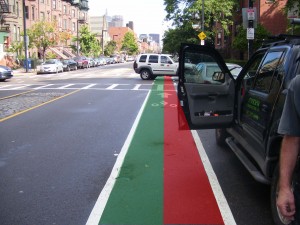Who does not
love bike lanes in Portland, Oregon?
Many bicycle commuters in this city rely on bike lanes to get them to
and from work and school safely each day.
Even non-bikers here have a soft spot for the extra lane. Additional bike lanes create more
infrastructure for active transportation, a movement that supports increased
health and decreased carbon emissions.
Unfortunately, bike lanes, while encouraging healthier, alternative
transportation options, do not always encourage safety.
This is partially because bike lanes can be inconsistent, disconnected, and un-buffered. The issue I’ll be focusing on is buffering. While ODOT and county governments have recommended standards and best practices, laws requiring and regulating bike lanes are unclear and in some cases nearly non-existent.[1] Especially in Portland, this issue needs to be addressed, potentially with city ordinances, or on a larger metropolitan regional scale with county laws or Metro resolutions. This is a Portland-wide issue, especially as many bicyclists commute from one part of the metropolitan area to another for work.
This is partially because bike lanes can be inconsistent, disconnected, and un-buffered. The issue I’ll be focusing on is buffering. While ODOT and county governments have recommended standards and best practices, laws requiring and regulating bike lanes are unclear and in some cases nearly non-existent.[1] Especially in Portland, this issue needs to be addressed, potentially with city ordinances, or on a larger metropolitan regional scale with county laws or Metro resolutions. This is a Portland-wide issue, especially as many bicyclists commute from one part of the metropolitan area to another for work.
Bike lanes
come in many designs and sizes. Some
bike lanes offer a buffer from traffic; some are buffered from parked cars; others
offer no buffer at all. Buffers are
semi-controversial, with some bicyclists and non-bicyclists alike (including members
of this class) arguing that the lack of a buffer makes motor vehicle drivers
more aware and cautious. In a study
conducted here in Portland, however, bicyclists noted their increased
perception of safety on streets that had buffered bike lanes installed one year
prior.[2] This increased perception of safety led to a
tangible increase in ridership in the monitored areas ranging from
77%-271%. These buffered lanes were
added to streets that had no bike lanes previously, so the addition of the
designated lane, and not the buffering, was the principal in increasing
ridership. In the study, however,
bicyclists noted that they felt at “lower risk of being ‘doored’ in the
buffered bike lanes,” which may have directly contributed to their increased
feeling of safety and potentially had an impact on increased ridership.[3]
Figure 1- Demonstrating the portion of
the bike lane in danger of being “doored”
by parked cars.[4]
In my
opinion, all bike lanes should be buffered.
This safety measure has a correlation with increased ridership, the
ultimate goal of creating larger and safer bike infrastructure. If buffering standards were required by city
ordinances or regional laws, bicycling infrastructure throughout Portland might
become less piecemeal and more congruous.
Improved consistency, mixed with the increased perception of safety that
accompanies a buffer lane, has the potential to increase bicycle commuting
throughout the region. It is important,
however, that specifications be made to protect bicyclists from both traffic
and parked cars; figure one above demonstrates how dangerous an open door can
be to a bicyclist. The law need not be overly prescriptive, allowing for
different designs on different streets.
Cycle tracks, for instance, function very well in some parts of the
region, including the grid streets of downtown, but would not work along Canyon
Road in Beaverton and West Slope. In
places with no on street parking, like in-city highways, a parking buffer need
not be required. And for roads that
simply cannot accommodate the extra space needed for the buffer, like the
narrow streets of Southeast Portland, exceptions must be written into the
law. In spite of this flexibility and the
inclusion of exceptional circumstances, a legal standard for infrastructure
would create a transportation development culture that values consistency and
safety.
These
policies have the potential to create a bicycling system that offers more
respect to bicyclists and a more continuous, safe network. As is discussed in Pucher’s and Dijkstra’s
article about pedestrian and biking facilities in the Netherlands and Germany,
more legal policies favor bicyclists and pedestrians in those countries than in
the United States.[5] They argue that such politics have a direct
correlation with the high ridership and bicycle oriented culture in German and
Dutch cities. While buffering would not
recreate the bicycle-centric ideology of those countries here in Portland, it
may serve as a notification to both bicyclists and motor vehicle operators that
bicycles belong on the road, and they will be accommodated accordingly. It may also give novice bicyclists, like me,
the confidence they need to ride not simply for recreation, but on a day to day
utilitarian basis.
Overall, the
benefits of buffering bike lanes, when possible, should not be ignored. Bicycling will only grow in this region when
the bike lane network becomes more continuous and the conditions become safer.


No comments:
Post a Comment
Note: Only a member of this blog may post a comment.